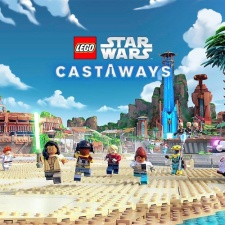No matter the size of the game or how long it ultimately takes to make, each new title involves a lot of hard work, tough decisions, and a little bit of luck before it even gets out the door and onto devices.
And that's only the first step to making the title succeed.
To highlight the extensive work that goes unseen in the background, PocketGamer.biz is reaching out to developers to learn more about the process of releasing a video game, with our 'Making Of' series.
This week, we spoke to Gameloft Montréal senior producer and creative director, Lee Kaburis and Jacques Durand, about how Lego Star Wars: Castaways was built "from the ground up" for Apple Arcade and the challenges that came along.
PocketGamer.biz: Where did the initial idea for Lego Star Wars: Castaways come from?
Jacques Durand: A few years ago, Apple, Lego, and Disney introduced us to Lucasfilm Games with an idea that is now today Lego Star Wars: Castaways. They wanted a Lego Star Wars game with unique social features and new types of gameplay, and with our experience working with each organisation, we were a perfect fit.
For the narrative, Lucasfilm Games had an outline of a clear storyline. After all, this was the first Lego Star Wars game that would introduce a new piece of lore in the Star Wars Universe, including a new planet, new cast of characters, and an ancient civilisation.
Throughout the development of the game, we worked closely with Lucasfilm’s story team to flesh out the backstory, establish the main characters, and more.
We worked very hard to design a world made entirely of Lego bricksJacques Durand
Finally, I would highlight the art direction. The brick is at the heart of the Lego brand experience. At the beginning of the project, we asked ourselves how to make the visually iconic Lego system be front and center in the game.
This led us to start thinking about the art direction. We worked very hard to design a world made entirely of Lego bricks, which is a challenge in itself, but we’re confident we made something really special.
How long did development take, and how many people worked on the game?
Lee Kaburis: The development of the game took about two years with a dev team of about 50 people in Gameloft’s Montréal studio - with additional help from various support teams such as audio, engine, localisation and QA.
What was the biggest challenge or setback you had to overcome during development?
Durand: I would say there were two major unique challenges we wanted to tackle. The first is the Art Direction. All of the game’s environments are 100 per cent built with Lego bricks, which fully immerse players in a Lego world. But at the same time, we wanted to be truthful with the scale of the locations as portrayed in the movies.
To maintain this level of authenticity, there was a big challenge of replicating the scale. Physical toy sets do a great job of packaging the essence of a Star Wars location inside a box, but we often needed bigger assets than those that are available on store shelves.
But whenever possible, we added actual Lego sets in the game such as the Millennium Falcon (7541 pieces) and the Mos Eisley Cantina (3187 pieces).
An interesting anecdote about the Falcon: There are many Lego sets of the Falcon. The first version we used in the game was the 75257 model (1351 pieces). The scale of the ship felt odd in the level, it simply wasn’t big enough! So, we turned to the Ultimate Collector Series version. Its ship-to-Minifigure ratio is closer to what we see in the movies.
The biggest challenge by far was to create the Social Hub. This environment is completely new to the world of Star Wars. We first had to design it in collaboration with Lucasfilm Games. There was lots of concept art and discussions. Once we passed this phase, we then proceeded to make it in Lego bricks.
The biggest challenge was adapting the user experience to the various input devicesJacques Durand
The second major challenge was cross-platform optimisation. Making a game that can be played seamlessly on all Apple platforms, such as the iPhone, iPad, Mac, and Apple TV has a lot of perks but isn’t quite as easy as you’d think.
There was a bit of a technical challenge to adapt to various screens’ resolution and screen size ratio. The art direction of the game made it extra challenging to ensure the game was performing well on low-end devices. But we also wanted to make it shine on high-end devices, to give it the console feel you can have while playing on a big screen TV in your living room.
But the biggest challenge was adapting the user experience to the various input devices. Not only are we developing a game with various game modes and 3Cs - camera, control, and character - but we also had to make sure the game plays well on touch-based devices, game controllers, or keyboard and mouse.
Lastly, we had to adapt to various player profiles. Early playtests revealed that not all players have the same level of play experience. Younger players would place the mobile device flat on a table and play with one finger. To reach a wide audience, we had to take nothing for granted. So, the game tutorial covers basic things like how to hold a device and play with two thumbs.
Were there additional stages in developing a game with an already established IP?
Kaburis: When working with a beloved franchise, it’s important to have a strong relationship with all the stakeholders involved. Gameloft collaborated with Disney and Lego on separate games before, but this was our team’s first time working with Lucasfilm Games.
Obviously, robust approval processes had to be put in place for this project. But beyond the procedure, what remained key throughout the production is how to work together to make the game relevant for all stakeholders.
When working with a beloved franchise, it’s important to have a strong relationship with all the stakeholders involvedLee Kaburis
Lego is a unique company with a strong purpose and a compelling mission; to promote learning through play by teaching kids how to collaborate, solve problems, to be resilient and creative. Lego relevancy is all about making a game that looks and feels like the iconic play system: creativity, accessibility, discovery, and replayability.
Lucasfilm Games had similar guidelines. They have the very richest stories to draw upon, and that’s a serious game to bring to fruition. We really wanted to lean into those elements that we love about Star Wars and which connect with many people, the battles between good and evil, the incredible technology and lightsabers, the funny or thrilling characters, the amazing Force powers. It’s all super cool.
Finally, there is Apple. Apple Arcade has established itself on mobile, desktop and the living room with its strong catalogue of curated games. To be relevant on Apple Arcade meant to carry out Gameloft's reputation of creating visually stunning and polished games, and to meet Apple Arcade high standards of excellence.
At what stage in development did you feel you had a game that you were happy with?
Durand: Iteration is key. We worked with an agile methodology which allowed us to progress incrementally at every milestone.
In parallel to the game’s development, we also conducted regular playtest sessions. The "magic" began to really happen earlier this year. We had various groups of players, young and old, but we also had families playing together. This is the moment where we saw the game deliver on the initial vision: family members having loads of fun together in a multiplayer session.
Apple had always positioned its subscription service to be family friendly: No microtransactions, or advertisements, a respect of user privacy, a commitment to digital child safety, and the ability to share the subscription with up to six family members. So, we were all thrilled to see it all come together!
When was the decision made to launch to game via Apple Arcade? And why?
Kaburis: It was always the case. The game was built from the ground up for Apple Arcade.
What can you tell us about your plans in terms of updates?
Kaburis: The freemium model has been dominating the mobile gaming industry for years. But the recent success of the Apple Arcade subscription-based model changes the way users see mobile games, it changes a lot of things.
While we built Lego Star Wars: Castaways as a premium game, with a premium feel, we’ve always looked at it with a live-ops frame of mind. We wanted to build a platform on which we can expand. Something we can maintain for years to come.
We built Lego Star Wars: Castaways as a premium game, with a premium feelLee Kaburis
At Gameloft, we have a long experience in running live-ops games. We have dozens of active live-ops games with millions of players. For Lego Star Wars: Castaways, we’re using what we’ve learned from more than a decade of operating live-ops games to establish our post-launch philosophy.
The game’s conceit and original narrative story doesn’t bind us to a specific Star Wars movie release (or any other Star Wars content).
The game is set on a whole new world, in a distant future on the timeline of the Star Wars universe, and the narrative setting has a very clever twist which allows players to revisit content of the past (with iconic Star Wars characters, vehicles and locations). It also allows us to include any Star Wars content that could be coming out in the future.
As we’re now in the process of transitioning from product development to live operations, we can’t disclose much on our post-launch roadmap at this point. We can affirm our intention to build on the game’s strong foundations.
What can you tell us about your future mobile projects?
Kaburis: Gameloft is gearing up for a really big 2022! We can’t get too into the details right now, but we’re excited for the New Year, and we can’t wait to announce what’s next from us!






















